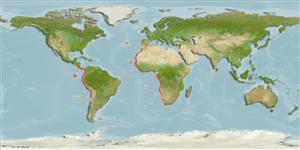>
Ateleopodiformes (Jellynose fishes) >
Ateleopodidae (Jellynose fishes)
Etymology: Guentherus: From Albert Günther (1830-1914), author of fifty volumes about fishes life in the British Museum (Ref. 45335).
Environment: milieu / climate zone / depth range / distribution range
Ökologie
seewasser bathydemersal; tiefenbereich 200 - 800 m (Ref. 6717). Deep-water; 42°N - 35°S, 92°W - 19°E
Eastern Atlantic: Portugal to South Africa. Eastern Central Pacific: Cabo Blanco and Quepos, Costa Rica and near Punta Jaqué, Panama (Ref. 9272); also Galapagos Islands (Ref. 9227).
Size / Gewicht / Alter
Maturity: Lm ? range ? - ? cm
Max length : 200 cm TL Männchen/unbestimmt; (Ref. 5528)
Rückenflossenstacheln (insgesamt) : 0; Rückenflossenweichstrahlen (insgesamt) : 11 - 13; Afterflossenstacheln: 0; Afterflossenweichstrahlen: 69 - 80. Adults dark brown, juveniles transparent with black blotches along body and fins (Ref. 5528).
Inhabits upper continental slopes (Ref. 27121). Benthic (Ref. 51024). Feeds on fishes (Ref. 6717).
Life cycle and mating behavior
Maturities | Fortpflanzung | Spawnings | Egg(s) | Fecundities | Larven
Costa, M.J. and J.-C. Quéro, 1990. Ateleopodidae. p. 644-645. In J.C. Quero, J.C. Hureau, C. Karrer, A. Post and L. Saldanha (eds.) Check-list of the fishes of the eastern tropical Atlantic (CLOFETA). JNICT, Lisbon; SEI, Paris; and UNESCO, Paris. Vol. 2. (Ref. 6550)
IUCN Rote Liste Status (Ref. 130435)
Bedrohung für Menschen
Harmless
Nutzung durch Menschen
Fischereien: kommerzielles potential
Tools
Zusatzinformationen
Download XML
Internet Quellen
Estimates based on models
Preferred temperature (Ref.
123201): 7.5 - 12.3, mean 9.6 °C (based on 83 cells).
Phylogenetic diversity index (Ref.
82804): PD
50 = 0.7502 [Uniqueness, from 0.5 = low to 2.0 = high].
Bayesian length-weight: a=0.01122 (0.00514 - 0.02450), b=3.04 (2.87 - 3.21), in cm total length, based on all LWR estimates for this body shape (Ref.
93245).
Trophic level (Ref.
69278): 3.5 ±0.42 se; based on food items.
Fishing Vulnerability (Ref.
59153): Very high vulnerability (90 of 100).
